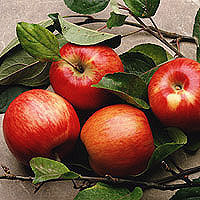Search Healthnotes
Apples

Varieties
Probably originating in southwestern Asia, the apples we know today descend from the wild crabapple, and date back some 3,000 years to the earliest orchards. Today more than 7,000 varieties can be found worldwide. Only a few of these are sold in supermarkets, however, even though about 2,500 known varieties are grown in the United States. The following are some of the most popular varieties:
Braeburn
With a color that can vary from gold with sections of red to nearly all red, the Braeburn is crisp and aromatic; its flavor is both sweet and tart. While it can be used in a number of ways, the Braeburn is best eaten out of hand and is one of the best all-around cooking apples. It is available from October through July.
Cortland
A cross between the Ben Davis and the McIntosh, it has a late autumn season. As it rarely discolors with oxidation, the Cortland adapts well to fruit salads. It is an all-purpose apple that stays firm when baked. It is moderately sweet and bright red with green streaks.
Empire
A combination of the McIntosh and Red Delicious, it holds up well to mishandling and keeps longer than the McIntosh. The Empire is dark red with darker spots, moderately sweet, and can be prepared raw or baked.
Fuji
The Fuji has a sweet taste and crisp texture making it ideal for salads or eating out of hand. Its color varies from yellow-green with red highlights to very red. It is available year-round.
Gaia
A variety created in New Zealand by crossing Cox’s Orange Pippin and Golden Delicious, the Gaia is crisp, sweet, and juicy. This pale yellow variety has light red streaks and can be prepared in many ways.
Gala
The heart-shaped Gala has a distinctive yellow-orange skin with red striping. It has a crisp, sweet taste that shows off best in salads and is good for snacking. Galas are available from August through March.
Golden delicious
Developed at a West Virginia farm around 1900, this apple is unrelated to the Red delicious. Pale green, it ripens to pale yellow, sometimes with light brown flecks. It is semi-firm, juicy, and sweet. Its rich, mellow flavor makes it excellent as applesauce or eaten raw. It holds its shape in cooking and is considered to be an all-purpose apple, especially in pies and other baked goods. It is available year-round.
Granny Smith
The Granny Smith apple tree was accidentally seeded around 1868 in Australia by a grandmother named Mrs. Smith. It is unique in its solid, bright green color, and is very firm, crisp, juicy, and somewhat tart. Often used in pies, it has a distinctive flavor, whether eaten from the hand or used raw in such dishes as Waldorf Salad. It is available year-round.
Greening
This green/yellow apple is found in Rhode Island. The season is from late autumn until spring. With their crispness and sharp flavor, Greening apples are primarily used in baking.
Honeycrisp
The state fruit of Minnesota, honeycrisp flavor ranges from mild to strongly aromatic, depending on maturity. The mostly red skin (with a hint of yellow behind) has shallow dimples and dots. Best used for eating and baking.
Idared
Pollinated in the 1940s by Jonathan Wagener, this is a red or bright red variety marked with yellow spots, and is firm and juicy. It performs well in desserts and cooking.
Jonagold
A blend of Jonathan and Golden Delicious apples, the Jonagold has a tangy-sweet flavor. It is greenish yellow in color, with a pinkish blush. The Jonagold is available from September through April and is a good choice for salads or baking, as well as snacking.
McIntosh
Canada’s national apple is delicious raw, baked, and in applesauce. This soft, juicy variety is blushed green to yellow with red stripes and has a slightly tart/sweet taste. It is available year-round.
Melba
Red with yellow streaks and very juicy, Melba apples cook down quickly and are therefore good for compotes and applesauce.
Pippin
There are several types of Pippin. The Newtown Pippin is green with yellow highlights. It is aromatic with a tangy flavor and is available September through June. It is excellent in salads and sauces as well as pies and other baked goods. Cox’s Orange Pippin, Britain’s most popular apple, has a season from late autumn to spring, peaking in midwinter. Its color is a dull brown-green with light red striping. The texture is crisp and it has a moderately sweet taste.
Red delicious
This top American apple originated in Iowa and is available year-round. It’s best in salads or eaten out of hand. The Red Delicious is heart-shaped and has five distinctive small “bumps” on the seed end. It is uniformly bright red or deep ruby in color, with a mildly sweet flavor and a crisp and juicy texture.
Rome Beauty
Named after its hometown of Rome, Ohio, this apple ripens to a deep bright red and lasts well after being picked. It is generally available September through July and can be used for all preparations, although it’s especially good for baking. Sweet in flavor, the Rome Beauty retains its shape when cooked.
Russet
The Russet name refers to a group of varieties, including the Golden Russet. As the name implies, the color is brown with light red markings, and the taste is similar to that of a pear. Russets are all-purpose apples.
Winesap
Because of its spicy, tart flavor, the Winesap is a popular apple to use in making cider. It is also good in salads and for baking and snacking. It has a deep, almost violet-red color, and is available from October through August.
Copyright © 2025 TraceGains, Inc. All rights reserved.
Learn more about TraceGains, the company.
The information presented in the Food Guide is for informational purposes only and was created by a team of US–registered dietitians and food experts. Consult your doctor, practitioner, and/or pharmacist for any health problem and before using any supplements, making dietary changes, or before making any changes in prescribed medications. Information expires December 2025.











